MFFSNet: A Lightweight Multi-Scale Shuffle CNN Network for Wheat Disease Identification in Complex Contexts
Abstract
:1. Introduction
- A novel lightweight network model (MFFSNet) was developed for wheat disease recognition in complex field backgrounds. MFFSNet employs a lightweight module to reduce parameters and enhance operational speed, making it suitable for real-time disease recognition.
- A multi-scale feature extraction (MFE) module was proposed, using dilated convolutions and the inception module to extract multi-scale feature information. This approach captures detailed and contextual information across multiple scales, improving disease recognition accuracy.
- A multi-scale feature fusion (MFF) module was introduced, which integrates the extracted multi-scale features. This module overcomes the challenge of fragmented feature representations by combining information from different scales, thereby enhancing the network’s ability to comprehensively recognize wheat diseases.
- An efficient channel attention mechanism was proposed to improve key feature recognition in complex backgrounds, enhancing model performance and reliability in real-world applications.
2. Materials and Methods
2.1. Datasets
2.2. Image Preprocessing
2.3. Experiment Details
2.4. Evaluation Indexes
2.5. Model Structure
2.6. Component Units
2.7. Dual-Branch Shuffle Attention (DSA)
2.8. Multi-Scale Feature Extraction and Fusion Module (MFEF)
2.8.1. Multi-Scale Feature Extraction Module (MFE)
2.8.2. Multi-Scale Feature Fusion Module (MFF)
3. Experiments and Results
3.1. Impact of the Position of MFEF Module
3.2. Comparative Experiment on Different Network Models
3.3. Results of Experiments for the Attention Mechanism
3.4. Comparison of Experiments Performed on Different Datasets
3.5. Comparison of Experiments on the Wheat Plant Diseases Dataset
3.6. Ablation Experiments
3.7. Visualization of Recognition Models and Results
4. Discussion
5. Conclusions
Author Contributions
Funding
Institutional Review Board Statement
Informed Consent Statement
Data Availability Statement
Acknowledgments
Conflicts of Interest
References
- Tian, Y.; Zhao, C.J.; Lu, S.G.; Guo, X.Y. Multiple Classifier Combination for Recognition of Wheat Leaf Diseases. Intell. Autom. Soft Comput. 2011, 17, 519–529. [Google Scholar]
- Azadbakht, M.; Ashourloo, D.; Aghighi, H.; Radiom, S.; Alimohammadi, A. Wheat leaf rust detection at canopy scale under different LAI levels using machine learning techniques. Comput. Electron. Agric. 2019, 156, 119–128. [Google Scholar] [CrossRef]
- Dong, Z.; Ji, X.; Lai, C.S.; Qi, D. Design and Implementation of a Flexible Neuromorphic Computing System for Affective Communication via Memristive Circuits. IEEE Commun. Mag. 2023, 61, 74–80. [Google Scholar] [CrossRef]
- Ji, X.; Dong, Z.; Han, Y.; Lai, C.S.; Qi, D. A Brain-Inspired Hierarchical Interactive In-Memory Computing System and Its Application in Video Sentiment Analysis. IEEE Trans. Circuits Syst. Video Technol. 2023, 33, 7928–7942. [Google Scholar]
- Zhu, X.; Li, J.; Jia, R.; Liu, B.; Yao, Z.; Yuan, A.; Huo, Y.; Zhang, H. LAD-Net: A Novel Light Weight Model for Early Apple Leaf Pests and Diseases Classification. IEEE/ACM Trans. Comput. Biol. Bioinform. 2023, 20, 1156–1169. [Google Scholar] [CrossRef]
- Chen, J.; Chen, W.; Zeb, A.; Yang, S.; Zhang, D. Lightweight Inception Networks for the Recognition and Detection of Rice Plant Diseases. IEEE Sens. J. 2022, 22, 14628–14638. [Google Scholar]
- Bidarakundi, P.M.; Kumar, B.M. Coffee-Net: Deep Mobile Patch Generation Network for Coffee Leaf Disease Classification. IEEE Sens. J. 2025, 25, 7355–7362. [Google Scholar]
- Lu, J.; Hu, J.; Zhao, G.; Mei, F.; Zhang, C. An in-field automatic wheat disease diagnosis system. Comput. Electron. Agric. 2017, 142, 369–379. [Google Scholar] [CrossRef]
- Nema, S.; Dixit, A. Wheat leaf detection and prevention using support vector machine. In Proceedings of the 2018 International Conference on Circuits and Systems in Digital Enterprise Technology (ICCSDET), Kottayam, India, 21–22 December 2018; pp. 1–5. [Google Scholar]
- Abade, A.; Ferreira, P.A.; de Barros Vidal, F. Plant diseases recognition on images using convolutional neural networks: A systematic review. Comput. Electron. Agric. 2021, 185, 106125. [Google Scholar]
- Picon, A.; Alvarez-Gila, A.; Seitz, M.; Ortiz-Barredo, A.; Echazarra, J.; Johannes, A. Deep convolutional neural networks for mobile capture device-based crop disease classification in the wild. Comput. Electron. Agric. 2019, 161, 280–290. [Google Scholar] [CrossRef]
- Mi, Z.; Zhang, X.; Su, J.; Han, D.; Su, B. Wheat stripe rust grading by deep learning with attention mechanism and images from mobile devices. Front. Plant Sci. 2020, 11, 558126. [Google Scholar] [CrossRef] [PubMed]
- Albayrak, U.; Golcuk, A.; Aktas, S.; Coruh, U.; Tasdemir, S.; Baykan, O.K. Classification and Analysis of Agaricus bisporus Diseases with Pre-Trained Deep Learning Models. Agronomy 2025, 15, 226. [Google Scholar] [CrossRef]
- Pan, F.; He, D.; Xiang, P.; Hu, M.; Yang, D.; Huang, F.; Peng, C. DualTransAttNet: A Hybrid Model with a Dual Attention Mechanism for Corn Seed Classification. Agronomy 2025, 15, 200. [Google Scholar] [CrossRef]
- Ou, Y.; Yan, J.; Liang, Z.; Zhang, B. Hyperspectral Imaging Combined with Deep Learning for the Early Detection of Strawberry Leaf Gray Mold Disease. Agronomy 2024, 14, 2694. [Google Scholar] [CrossRef]
- Thakur, P.S.; Sheorey, T.; Ojha, A. VGG-ICNN: A lightweight CNN model for crop disease identification. Multimed. Tools Appl. 2023, 82, 497–520. [Google Scholar] [CrossRef]
- Zhang, P.; Yang, L.; Li, D. EfficientNet-B4-Ranger: A novel method for greenhouse cucumber disease recognition under natural complex environment. Comput. Electron. Agric. 2020, 176, 105652. [Google Scholar] [CrossRef]
- Barman, U.; Choudhury, R.D.; Sahu, D.; Barman, G.G. Comparison of convolution neural networks for smartphone image based real time classification of citrus leaf disease. Comput. Electron. Agric. 2020, 177, 105661. [Google Scholar] [CrossRef]
- Bao, W.; Yang, X.; Liang, D.; Hu, G.; Yang, X. Lightweight convolutional neural network model for field wheat ear disease identification. Comput. Electron. Agric. 2021, 189, 106367. [Google Scholar] [CrossRef]
- Li, G.; Jiao, L.; Chen, P.; Liu, K.; Wang, R.; Dong, S.; Kang, C. Spatial convolutional self-attention-based transformer module for strawberry disease identification under complex background. Comput. Electron. Agric. 2023, 212, 108121. [Google Scholar] [CrossRef]
- Goyal, L.; Sharma, C.M.; Singh, A.; Singh, P.K. Leaf and spike wheat disease detection & classification using an improved deep convolutional architecture. Inform. Med. Unlocked 2021, 25, 100642. [Google Scholar]
- Ioffe, S.; Szegedy, C. Batch Normalization: Accelerating Deep Network Training by Reducing Internal Covariate Shift. Int. Conf. Mach. Learn. (ICML) 2015, 37, 448–456. [Google Scholar]
- Ma, N.; Zhang, X.; Zheng, H.-T.; Sun, J. ShuffleNet v2: Practical guidelines for efficient CNN architecture design. In Proceedings of the European Conference on Computer Vision (ECCV), Munich, Germany, 8–14 September 2018; pp. 116–131. [Google Scholar]
- Howard, A.G. MobileNets: Efficient convolutional neural networks for mobile vision applications. arXiv 2017, arXiv:1704.04861. [Google Scholar]
- Chen, J.; Kao, S.-H.; He, H.; Zhuo, W.; Wen, S.; Chan, C.-H.G. Run, don’t walk: Chasing higher FLOPS for faster neural networks. In Proceedings of the IEEE/CVF Conference on Computer Vision and Pattern Recognition, Vancouver, BC, Canada, 18–22 June 2023; pp. 12021–12031. [Google Scholar]
- Wang, Q.; Wu, B.; Zhuo, P.; Li, P.; Zuo, W.; Hu, Q. ECA-Net: Efficient channel attention for deep convolutional neural networks. In Proceedings of the IEEE/CVF Conference on Computer Vision and Pattern Recognition, Seattle, WA, USA, 14–19 June 2020; pp. 11534–11542. [Google Scholar]
- Zhang, Q.-L.; Yang, Y.-B. SA-Net: Shuffle attention for deep convolutional neural networks. In Proceedings of the ICASSP 2021—2021 IEEE International Conference on Acoustics, Speech and Signal Processing (ICASSP), Virtual, 6–12 June 2021; pp. 2235–2239. [Google Scholar]
- Liu, S.; Huang, D. Receptive field block net for accurate and fast object detection. In Proceedings of the European Conference on Computer Vision (ECCV), Munich, Germany, 8–14 September 2018; pp. 385–400. [Google Scholar]
- Yu, F.; Koltun, V. Multi-scale context aggregation by dilated convolutions. arXiv 2015, arXiv:1511.07122. [Google Scholar]
- Li, Y.; Hou, Q.; Zheng, Z.; Cheng, M.-M.; Yang, J.; Li, X. Large selective kernel network for remote sensing object detection. In Proceedings of the IEEE/CVF International Conference on Computer Vision, Paris, France, 4–6 October 2023; pp. 16794–16805. [Google Scholar]
- Hou, Q.; Zhou, D.; Feng, J. Coordinate attention for efficient mobile network design. In Proceedings of the IEEE/CVF Conference on Computer Vision and Pattern Recognition, Nashville, TN, USA, 19–25 June 2021; pp. 13713–13722. [Google Scholar]
- He, K.; Zhang, X.; Ren, S.; Sun, J. Deep residual learning for image recognition. In Proceedings of the IEEE Conference on Computer Vision and Pattern Recognition, Las Vegas, NV, USA, 27–30 June 2016; pp. 770–778. [Google Scholar]
- Szegedy, C.; Liu, W.; Jia, Y.; Sermanet, P.; Reed, S.; Anguelov, D.; Erhan, D.; Vanhoucke, V.; Rabinovich, A. Going deeper with convolutions. In Proceedings of the IEEE Conference on Computer Vision and Pattern Recognition, Boston, MA, USA, 7–12 June 2015; pp. 1–9. [Google Scholar]
- Huang, G.; Liu, Z.; van der Maaten, L.; Weinberger, K.Q. Densely connected convolutional networks. In Proceedings of the IEEE Conference on Computer Vision and Pattern Recognition, Honolulu, HI, USA, 21–26 July 2017; pp. 4700–4708. [Google Scholar]
- Sandler, M.; Howard, A.; Zhu, M.; Zhmoginov, A.; Chen, L.-C. MobileNetV2: Inverted residuals and linear bottlenecks. In Proceedings of the IEEE Conference on Computer Vision and Pattern Recognition, Salt Lake City, UT, USA, 18–22 June 2018; pp. 4510–4520. [Google Scholar]
- Howard, A.; Sandler, M.; Chu, G.; Chen, L.-C.; Chen, B.; Tan, M.; Wang, W.; Zhu, Y.; Pang, R.; Vasudevan, V.; et al. MobileNetV3. In Proceedings of the IEEE/CVF International Conference on Computer Vision, Seoul, Republic of Korea, 27 October–2 November 2019; pp. 1314–1324. [Google Scholar]
- Tan, M.; Le, Q. EfficientNet: Rethinking model scaling for convolutional neural networks. In Proceedings of the 36th International Conference on Machine Learning, Long Beach, CA, USA, 9–15 June 2019; pp. 6105–6114. [Google Scholar]
- Liu, Z.; Lin, Y.; Cao, Y.; Hu, H.; Wei, Y.; Zhang, Z.; Lin, S.; Guo, B. Swin transformer: Hierarchical vision transformer using shifted windows. In Proceedings of the IEEE/CVF International Conference on Computer Vision, Montreal, BC, Canada, 11–17 October 2021; pp. 10012–10022. [Google Scholar]
- Hu, J.; Shen, L.; Sun, G. Squeeze-and-excitation networks. In Proceedings of the IEEE Conference on Computer Vision and Pattern Recognition, Salt Lake City, UT, USA, 18–22 June 2018; pp. 7132–7141. [Google Scholar]
- Zhou, B.; Khosla, A.; Lapedriza, A.; Oliva, A.; Torralba, A. Learning deep features for discriminative localization. In Proceedings of the IEEE Conference on Computer Vision and Pattern Recognition, Las Vegas, NV, USA, 27–30 June 2016; pp. 2921–2929. [Google Scholar]
- Yang, Q.; Duan, S.; Wang, L. Efficient identification of apple leaf diseases in the wild using convolutional neural networks. Agronomy 2022, 12, 2784. [Google Scholar] [CrossRef]
- kushagra3204. Wheat Plant Diseases [Dataset]. Kaggle. 2024. Available online: https://www.kaggle.com/datasets/kushagra3204/wheat-plant-diseases/data (accessed on 1 March 2025).


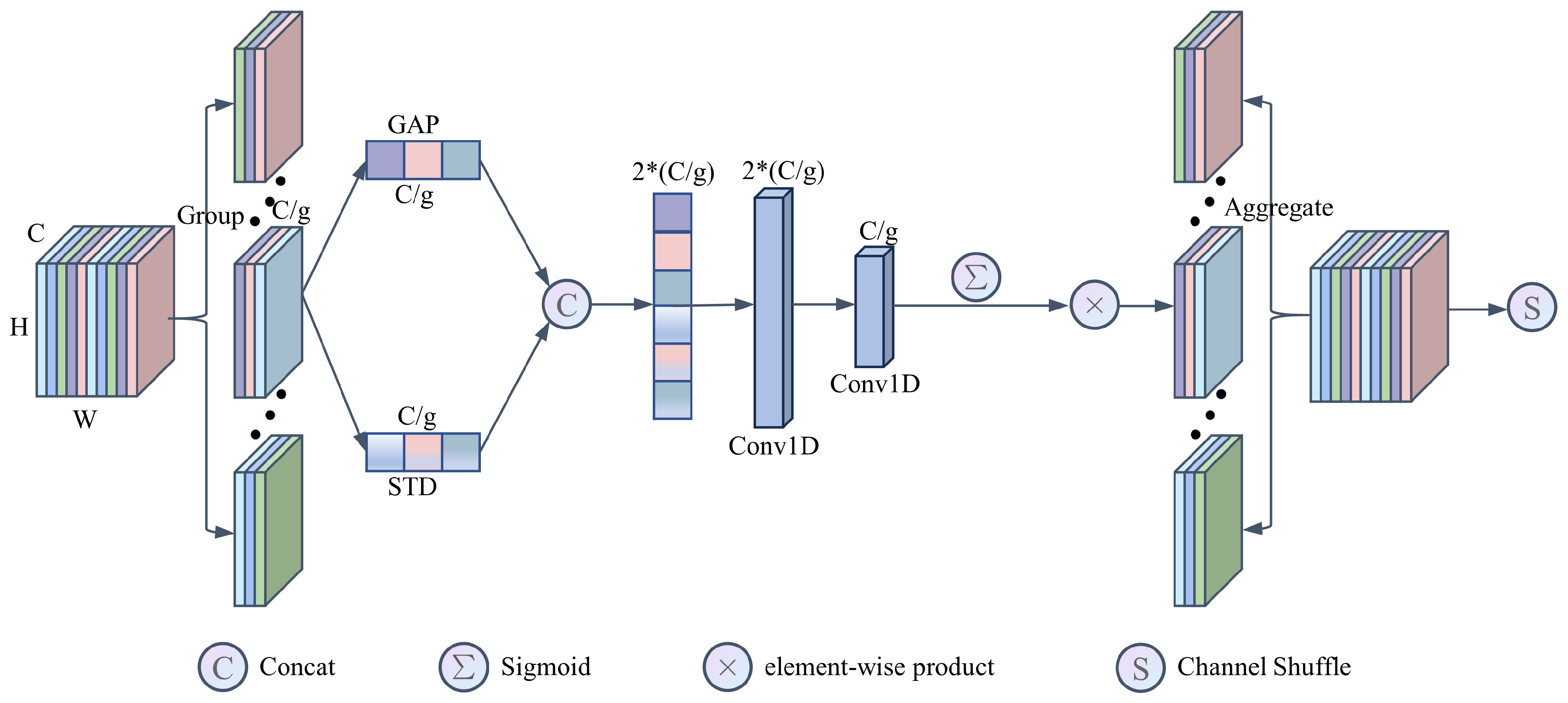


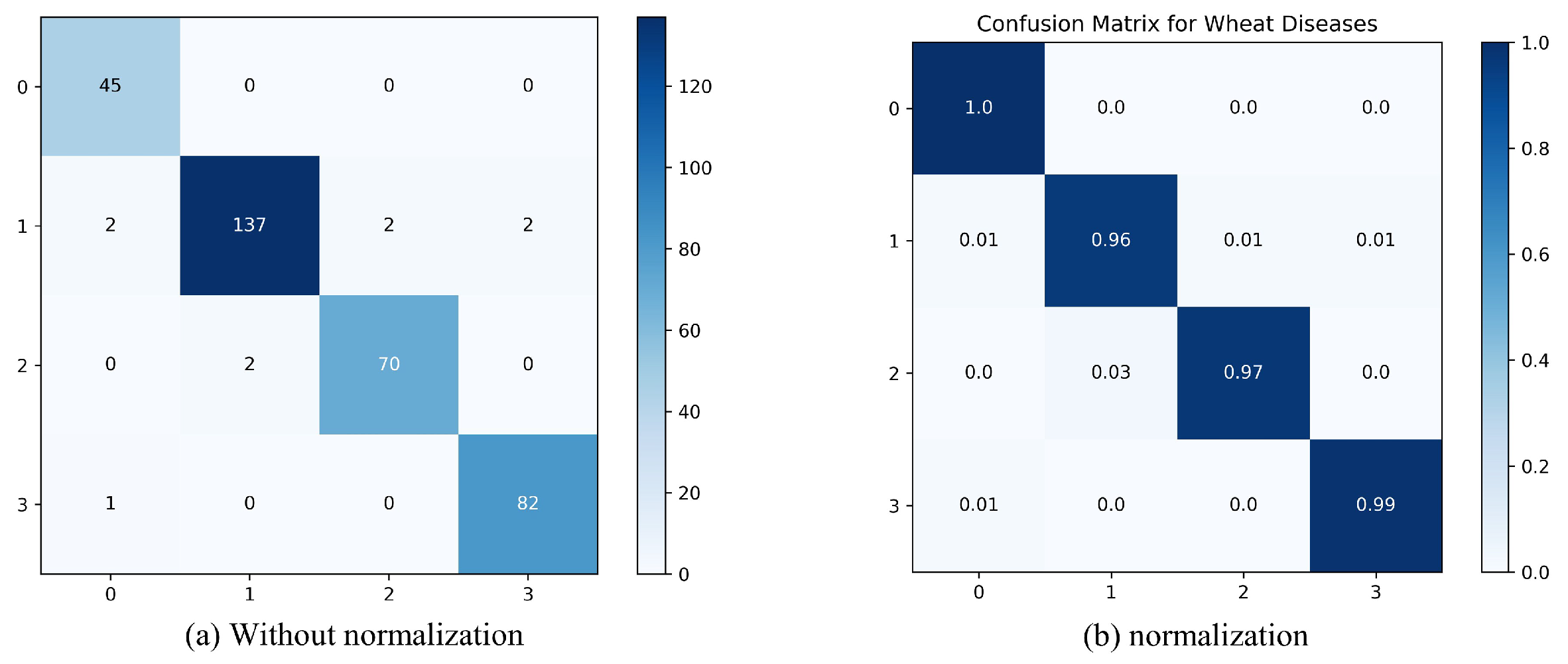

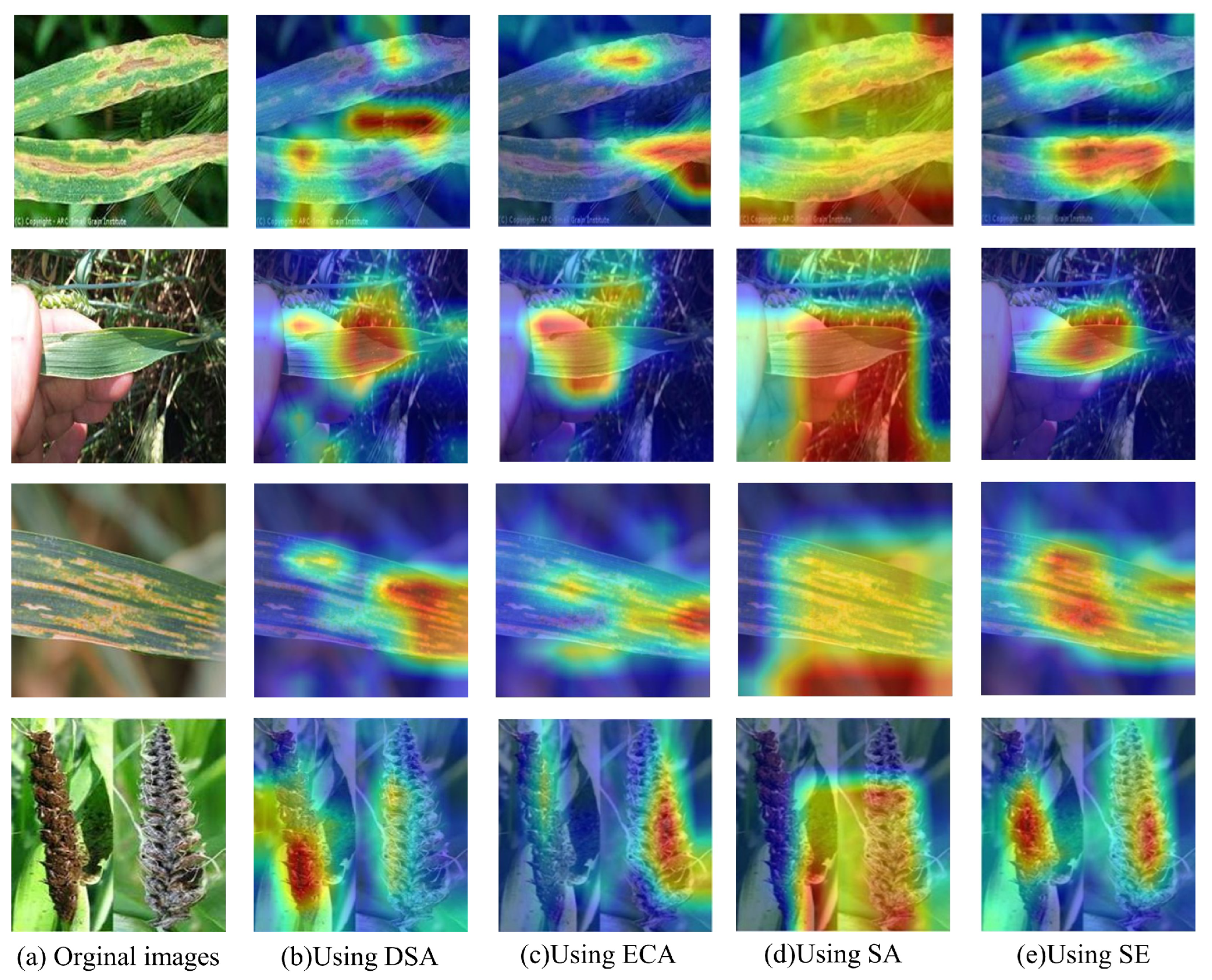
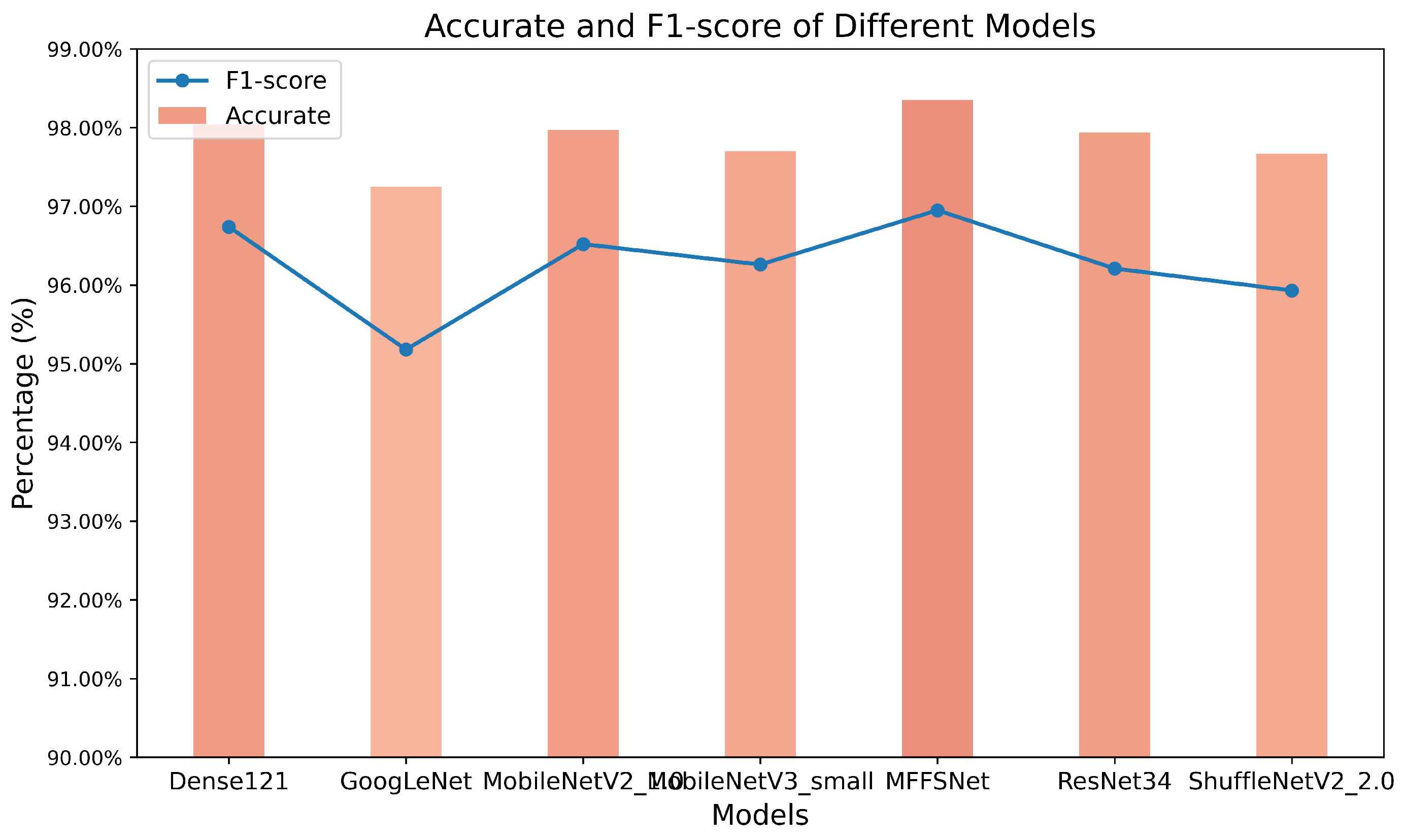


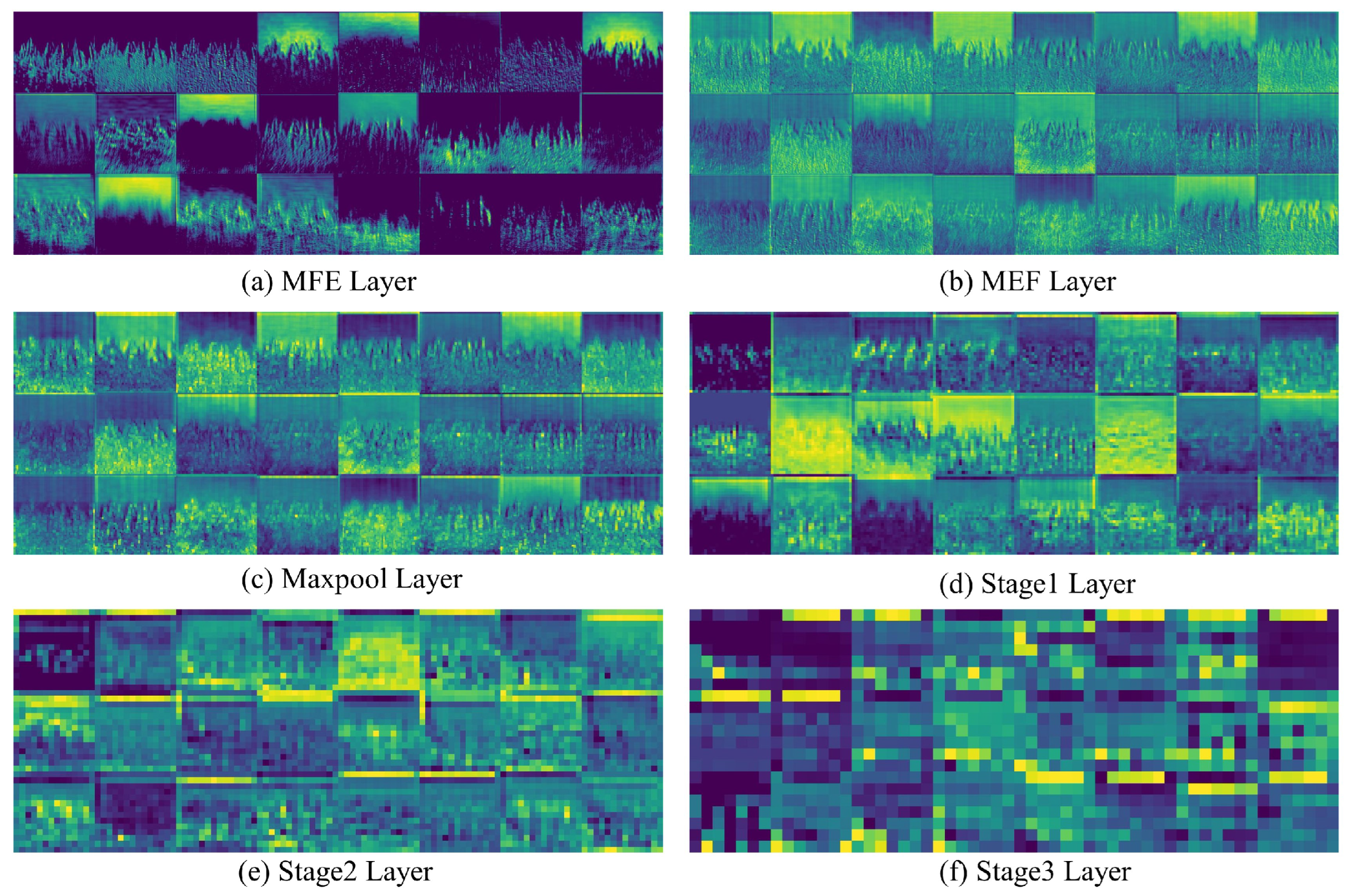
| Type | Crown and Root Rot | Healthy Wheat | Leaf Rust | Wheat Loose Smut |
| Numbers | 45 | 143 | 72 | 83 |
| Parameter | Value |
|---|---|
| Optimization | Adam |
| Learning rate | 0.001 |
| Weight decay | 5.00 × 10−4 |
| Epoch | 250 |
| Batch size | 16 |
| GPU | NVIDIA GeForce RTX 3060 |
| Layer | Output Size | Configurations | Repeat | Output Channels |
|---|---|---|---|---|
| Input | images | 1 | 3 | |
| Conv1 () | Conv (stride = 2), BN, Relu6 | 1 | 24 | |
| MFEF | MFE, MFF | 1 | 24 | |
| MaxPool () | stride = 2 | 1 | 24 | |
| Stage2 | stride = 2 unit | 1 | 48 | |
| stride = 1 unit | 3 | 48 | ||
| Stage3 | stride = 2 unit | 1 | 96 | |
| stride = 1 unit | 7 | 96 | ||
| Stage4 | stride = 2 unit | 1 | 192 | |
| stride = 1 unit | 3 | 192 | ||
| Conv5 () | Conv(stride = 1), BN, Relu6 | 1 | 1024 | |
| GlobalPool () | 1 | |||
| Classifier | 1 | 4 |
| Methods | Acc (%) | Precision (%) | Recall (%) | F1-score (%) | FLOPs (G) | Params (M) |
|---|---|---|---|---|---|---|
| GoogleNet | 94.46 | 93.43 | 94.68 | 93.98 | 25.31 | 5.98 |
| DenseNet-121 | 96.50 | 95.93 | 96.33 | 96.12 | 46.34 | 6.96 |
| MobileNetV2 | 95.92 | 95.24 | 95.94 | 95.56 | 5.22 | 2.23 |
| MobileNetV3 Small | 95.67 | 94.86 | 95.25 | 95.02 | 0.98 | 1.52 |
| ShuffleNetV2 | 96.50 | 95.84 | 97.30 | 96.52 | 9.54 | 5.35 |
| EfficientNetV2-S | 95.92 | 95.49 | 96.28 | 95.83 | 46.36 | 20.18 |
| Swin Transformer | 95.63 | 95.90 | 95.63 | 95.64 | 69.94 | 27.50 |
| Proposed model (MFFSNet) | 97.38 | 96.79 | 97.96 | 97.34 | 1.58 | 0.45 |
| Methods | ECA | DSA | MFE | LSK | MFF | Acc (%) | Pre (%) | Recall (%) | F1 (%) |
|---|---|---|---|---|---|---|---|---|---|
| MFFSNet | ✓ | ✓ | ✓ | 95.63 | 95.37 | 94.96 | 95.10 | ||
| ✓ | ✓ | ✓ | 96.34 | 96.17 | 95.66 | 95.89 | |||
| ✓ | ✓ | 95.63 | 94.76 | 95.00 | 94.82 | ||||
| ✓ | ✓ | ✓ | ✓ | 96.50 | 95.94 | 97.01 | 96.42 | ||
| ✓ | ✓ | ✓ | ✓ | 97.38 | 96.79 | 97.96 | 97.34 |
Disclaimer/Publisher’s Note: The statements, opinions and data contained in all publications are solely those of the individual author(s) and contributor(s) and not of MDPI and/or the editor(s). MDPI and/or the editor(s) disclaim responsibility for any injury to people or property resulting from any ideas, methods, instructions or products referred to in the content. |
© 2025 by the authors. Licensee MDPI, Basel, Switzerland. This article is an open access article distributed under the terms and conditions of the Creative Commons Attribution (CC BY) license (https://creativecommons.org/licenses/by/4.0/).
Share and Cite
Xie, M.; Wu, J.; Sun, J.; Xiao, L.; Liu, Z.; Yuan, R.; Duan, S.; Wang, L. MFFSNet: A Lightweight Multi-Scale Shuffle CNN Network for Wheat Disease Identification in Complex Contexts. Agronomy 2025, 15, 910. https://doi.org/10.3390/agronomy15040910
Xie M, Wu J, Sun J, Xiao L, Liu Z, Yuan R, Duan S, Wang L. MFFSNet: A Lightweight Multi-Scale Shuffle CNN Network for Wheat Disease Identification in Complex Contexts. Agronomy. 2025; 15(4):910. https://doi.org/10.3390/agronomy15040910
Chicago/Turabian StyleXie, Mingjin, Jiening Wu, Jie Sun, Lei Xiao, Zhenqi Liu, Rui Yuan, Shukai Duan, and Lidan Wang. 2025. "MFFSNet: A Lightweight Multi-Scale Shuffle CNN Network for Wheat Disease Identification in Complex Contexts" Agronomy 15, no. 4: 910. https://doi.org/10.3390/agronomy15040910
APA StyleXie, M., Wu, J., Sun, J., Xiao, L., Liu, Z., Yuan, R., Duan, S., & Wang, L. (2025). MFFSNet: A Lightweight Multi-Scale Shuffle CNN Network for Wheat Disease Identification in Complex Contexts. Agronomy, 15(4), 910. https://doi.org/10.3390/agronomy15040910







